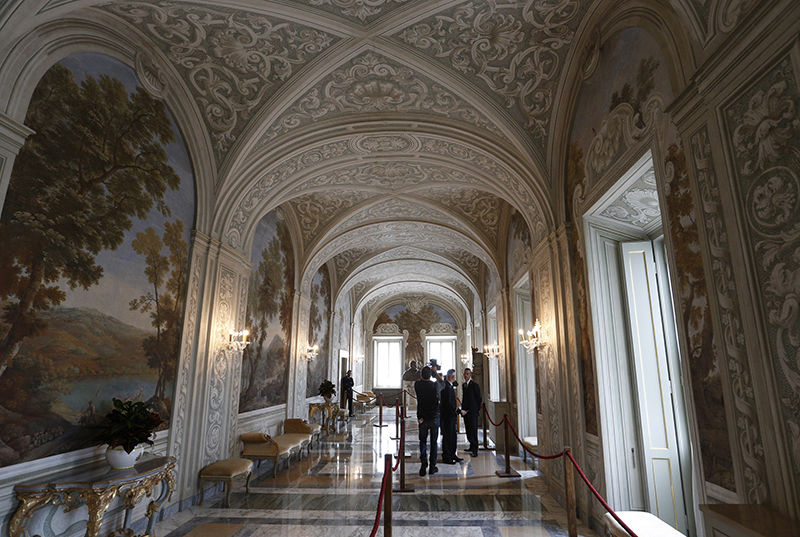Because Pope Francis isn’t using the traditional papal summer residence at Castel Gandolfo, and apparently has no plans ever to do so, beginning today the Vatican has flung open its doors to the public, turning it into a museum and, at the same time, giving a badly needed shot in the arm to local businesses that desperately miss the pope’s presence.
To mark the day, it’s worth recalling that the doors of Castel Gandolfo have been flung open to the public before — only not for a tour, but to save the lives of people in desperate circumstances, turning the papal palace into one of the most unusual, and courageous, refugee centers ever operated by the Catholic Church.
In January 1944, after Italy had been occupied by Nazi forces, the area of the Castelli Romani where Castel Gandolfo is situated, was the scene of some of the fiercest fighting of the Second World War. Thousands of people were turned into refugees and displaced persons overnight, and scores of others saw their names placed on death lists for sympathizing with the partigiani, meaning the Italian resistance fighters.
At that time Pope Pius XII was essentially a “prisoner of the Vatican,” unable to leave the 108-acre space within the Vatican walls, in part for fear of being arrested by the Nazis should he do so. His young secretary, Msgr. Giovanni Battista Montini — the future Pope Paul VI — informed him of the situation in the area around Castel Gandolfo, and the decision to throw open the papal palace was made without hesitation.
On Jan. 22, 1944, the doors were opened to anyone wishing to enter, and eventually some 12,000 people were accommodated on the grounds that have a larger physical footprint than the Vatican itself. No one was asked to produce a baptismal certificate, and no one was asked their political affiliation. Among the people taking shelter under the protection of the pope were many Roman Jews.
It was, to be clear, a risky move by Pius XII, the last native Roman-born pontiff. Although Castel Gandolfo enjoys extra-territorial status as Vatican property, and thus is theoretically inviolable, he knew he could be turning the compound into a target for the Germans.
He also knew, of course, that caring for such a large mass of people would further drain the Vatican’s already depleted resources in a time of war.
As it turns out, no bomb ever struck Castel Gandolfo, but the risks were clear. In February 1944, a bomb destroyed a nearby Poor Clare convent, killing 16 sisters, and another struck a college run by Propaganda Fidei, killing 500.
Among other things, 36 babies were born in the papal palace of Castel Gandolfo during that period, cared for in the pope’s private apartment, which was turned into a makeshift nursery.
From the “only in Italy” files, two of those Castel Gandolfo babies, Eugenio Pio and Pio Eugenio Zevini, the only twins born in those days, explained in a 2004 interview that they went on to become lifelong Communists, following the example of their partigiano father (and also defying the Vatican’s explicit call to Italians to support Christian Democracy), but at the same time they’re also fierce defenders and advocates of Pius XII.
“We’re honored to carry the name of that pope,” they said, referring to the fact that both are named for Pius XII, as are almost all of the 36 children born in the palace in those days. “He performed a noble gesture, and we can never forget it.”
In January 1944, Allied forces had come ashore in Italy at Anzio, on the coast of the Lazio region that includes Rome. The Zevinis were already conceived at that time but not yet born, and their mother lived in daily fear of both Allied bombardments and Nazi reprisals. Calculating that no one would bomb the papal palace, she relocated the family there.
Some of the refugees, especially the weakest and the elderly, lived inside buildings on the grounds of the papal residence, others in hastily constructed wooden shacks and tents erected on the grounds. One survivor, who went on to become the local mayor, would recall that entire families arrived with their cows, horses, mules and sheep.
“It was like an immense Noah’s Ark,” he said.
Today, Pope Francis is legendarily a voice of compassion for refugees and the victims of war, and he’s called upon Catholic facilities across Europe to open their doors to people in need. The story of Castel Gandolfo is a powerful reminder that in doing so, he’s not creating a tradition — he’s reviving one.
This article origianlly appeared at the Catholic news site cruxnow.com

